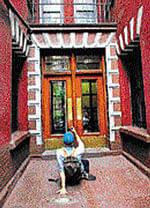Applications fuel growth of iphotography

Instead, everyone carried an iPhone and snapped photos with enthusiasm. Most were San Francisco residents who had gathered in Chinatown on a warm Saturday morning to take part in an “Instawalk,” an ad hoc gathering of iPhone photography enthusiasts who share their pictures via Instagram, the popular iPhone photo service that has more than seven million users.
The tours are led by Brian Roberts, better known to his Instagram fans as Doctor Popular. With help from the Instagram app, Doctor Popular’s remarkable photographs have quickly established him as an innovator who uses the iPhone as a powerful tool for creative expression.
The most important part of the tours he organises occurs afterward, when participants gather at a Chinatown cocktail bar to drink and review the photos. “Have you tried the Synthcam app?” asked Doctor Popular, 34, a community manager at Postagram, an iPhone app developer. “It was made by a bunch of Stanford professors. It’s great for creating shallow depth of field.”
“There’s a new art form emerging,” he said. “I used to react badly when people would call it ‘iPhotography,’ because that seemed too contrived. Yet more and more, I feel that this type of photography is really its own thing.”
The growth of iPhotography has been fueled by the thousands of inexpensive photography apps offered on Apple’s App Store. Android stores also have photo apps. App developers have released an impressive array of tools that can do basic retouching tasks like enhancing brightness, clarity and contrast, or stranger tricks like merging images or deconstructing a photo into patterns and colors. Percolator, for instance, converts images into colorful mosaics that look almost like stained glass. Another app, called Interlacer threads two images together, line by line, to create images that appear as if they were displayed on a vintage color television in need of repair.
For some smartphone users, the aha! moment comes when they realise the device can do more than just capture crude snapshots of cats or pictures of dinner. “The big shift happens when you go from using the camera to document daily life to thinking of it as a tool for photography,” Doctor Popular said.
While experimenting with dozens of photo apps, he developed his signature approach to iPhone photography: Instead of just editing an image with one app, he often runs it through several apps, one after the other, in a specific sequence. His process generates unusual photographs that betray little evidence that they were created entirely on a mobile phone.
In one recent image, he took two pictures of the high-rise skyline of downtown San Francisco. He then used the Decim8 app to break up the pattern of the images, and the StripeCam app to enhance the vertical lines of the buildings. Finally, he used the TrueHDR app to combine the two images and create a “ghosting” effect.
He often includes production notes with his photos on Instagram as guidance for fans and would-be imitators. “Shot with the regular camera app, then run through #Decim8, then merged with #TrueHDR,” is a typical example.
Such app recommendations are invaluable, because in a paradoxical way the expensive iPhone, which starts at $199, is a very egalitarian photography device.
With traditional cameras, advanced techniques often require expensive gear like specialised lenses, filters and lighting. Throw in a personal computer and shrink-wrapped image editing software that can cost well over $600, and D.S.L.R. photography quickly becomes a very expensive hobby.
The iPhone, by contrast, is a level and affordable playing field for aspiring photographers because everyone starts with the same device and most photography apps cost just a dollar or two.